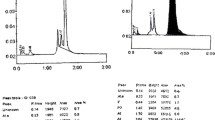Abstract
Glycated hemoglobin (HbA1c) is an important indicator of glycemic control in patients with diabetes. High-performance liquid chromatography (HPLC) is the most commonly used method for measuring HbA1c levels; as HPLC measures all hemoglobin types, the values can be influenced by hemoglobin variants. Moreover, as HPLC-HbA1c levels are low in some diseases, including hemolytic anemia, it may be difficult to differentiate hemoglobin variants from these diseases based on HPLC-HbA1c levels alone. Similar HbA1c values using both HPLC and immunoassays (IAs) are noted for these diseases, while discrepancies are noted in the case of hemoglobin variants. Herein, we describe our process of differential diagnosis for hereditary spherocytosis, the most common inherited hemolytic anemia, in a 56-year-old man presenting with a low HPLC-HbA1c level compared to the glucose concentration, concomitant with anemia, jaundice, hyperbilirubinemia, cholelithiasis, and splenomegaly. There was a discrepancy between HbA1c levels measured with HPLC and IAs and glycated albumin levels. The possibility of hemoglobin variants was unlikely, based on the chromatography and isoelectric focusing results. The haptoglobin levels and reticulocyte counts were low and high, respectively. The direct and indirect Coomb’s tests were negative. The presence of spherocytes on blood smears and flow cytometric analysis of the eosin-5-maleimide binding test supported a diagnosis of hereditary spherocytosis. We recommend that when a discrepancy between HPLC-HbA1c levels and glucose concentrations is noted, clinicians should consider hemolysis or hemoglobin variants as the diagnosis. It should be considered that a discrepancy between HbA1c levels measured with HPLC and IAs does not specifically exclude hemolysis.

Similar content being viewed by others
References
Sherwani SI, Khan HA, Ekhzaimy A, Masood A, Sakharkar MK. Significance of HbA1c test in diagnosis and prognosis of diabetic patients. Biomark Insight. 2016;11:95–104.
Oikawa J, Nakamura K, Ukawa S, Kishi T, Nakamura A, Tamakoshi A. Influence of different methods for measuring HbA1c on health checkups in a rural town in Hokkaido. Jpn Diabetol Int. 2016;7:391–7.
Miyazaki A, Kohzuma T, Kasayama S, Koga M. Classification of variant forms of haemoglobin according to the ratio of glycated haemoglobin to glycated albumin. Ann Clin Biochem. 2012;49:441–4.
Koga M, Kasayama S. Clinical impact of glycated albumin as another glycemic control marker. Endocrine J. 2010;57:751–62.
Jeffcoate SL. Diabetes control and complications: the role of glycated haemoglobin, 25 years on. Diabet Med. 2004;21:657–65.
Perrotta S, Gallagher PG, Mohandas N. Hereditary spherocytosis. Lancet (London, England). 2008;372:1411–26.
Koga M. Glycated albumin; clinical usefulness. Clin Chim Acta. 2014;33:96–104.
Koga M, Murai J, Soga S, Saito H. Study of five patients with variant hemoglobin based on abnormally low HbA1c values during routine medical examinations. J Jpn Diab Soc. 2013;56:841–8 (in Japanese).
Saito M. Common nonspecific reaction in routine work and method for confirming the reaction. J Anal Bio-Sci. 2017;40:156–61 (in Japanese).
King MJ, Behrens J, Rogers C, Flynn C, Greenwood D, Chambers K. Rapid flow cytometric test for the diagnosis of membrane cytoskeleton-associated haemolytic anaemia. Br J Haematol. 2000;111:924–33.
King MJ, Smythe JS, Mushens R. Eosin-5-maleimide binding to band 3 and Rh-related proteins forms the basis of a screening test for hereditary spherocytosis. Br J Haematol. 2004;124:106–13.
Farias MG. Advances in laboratory diagnosis of hereditary spherocytosis. Clin Chem Lab Med. 2017;55:944–8.
Fanhchaksai K, Manowong S, Natesirinilkul R, Sathitsamitphong L, Charoenkwan P. Flow cytometric test with eosin-5-maleimide for a diagnosis of hereditary spherocytosis in a newborn. Case Rep Hematol. 2019;2019:5925731.
Bolton-Maggs PH, Langer JC, Iolascon A, Tittensor P, King MJ. General Haematology Task Force of the British Committee for Standards in Haematology. Guidelines for the diagnosis and management of hereditary spherocytosis–2011 update. Br J Haematol. 2012;156:37–49.
Acknowledgements
We thank Dr.Yukio Hattori (Department of Clinical Laboratory, Saiseikai Yamaguchi General Hospital), Dr. Yasuhiro Yamashiro (Department of Health Sciences, Yamaguchi University Graduate School of Medicine), and the staff of Fukuyama Medical Laboratory for their support in performing laboratory tests and assistance in the diagnosis of this patient. We also thank Editage for their technical assistance by way of editing a draft of this manuscript.
Author information
Authors and Affiliations
Corresponding author
Ethics declarations
Conflicts of interest
The authors declare that they have no conflict of interest.
Ethical approval
All procedures followed were in accordance with the ethical standards of the responsible committee on human experimentation (institutional and national) and with the Helsinki Declaration of 1964 and later versions.
Informed consent
Informed consent was obtained from the patient included in this study.
Additional information
Publisher's Note
Springer Nature remains neutral with regard to jurisdictional claims in published maps and institutional affiliations.
About this article
Cite this article
Okamoto, T., Shima, H., Noma, Y. et al. Hereditary spherocytosis diagnosed with extremely low glycated hemoglobin compared to plasma glucose levels. Diabetol Int 12, 229–233 (2021). https://doi.org/10.1007/s13340-020-00456-4
Received:
Accepted:
Published:
Issue Date:
DOI: https://doi.org/10.1007/s13340-020-00456-4




